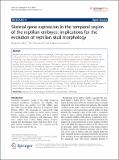| dc.contributor.author | Tokita, Masayoshi | en_US |
| dc.contributor.author | Chaeychomsri, Win | en_US |
| dc.contributor.author | Siruntawineti, Jindawan | en_US |
| dc.date.accessioned | 2014-05-06T16:17:24Z | |
| dc.date.issued | 2013 | en_US |
| dc.identifier.citation | Tokita, Masayoshi, Win Chaeychomsri, and Jindawan Siruntawineti. 2013. “Skeletal gene expression in the temporal region of the reptilian embryos: implications for the evolution of reptilian skull morphology.” SpringerPlus 2 (1): 336. doi:10.1186/2193-1801-2-336. http://dx.doi.org/10.1186/2193-1801-2-336. | en |
| dc.identifier.issn | 2193-1801 | en |
| dc.identifier.uri | http://nrs.harvard.edu/urn-3:HUL.InstRepos:12152903 | |
| dc.description.abstract | Reptiles have achieved highly diverse morphological and physiological traits that allow them to exploit various ecological niches and resources. Morphology of the temporal region of the reptilian skull is highly diverse and historically it has been treated as an important character for classifying reptiles and has helped us understand the ecology and physiology of each species. However, the developmental mechanism that generates diversity of reptilian skull morphology is poorly understood. We reveal a potential developmental basis that generates morphological diversity in the temporal region of the reptilian skull by performing a comparative analysis of gene expression in the embryos of reptile species with different skull morphology. By investigating genes known to regulate early osteoblast development, we find dorsoventrally broadened unique expression of the early osteoblast marker, Runx2, in the temporal region of the head of turtle embryos that do not form temporal fenestrae. We also observe that Msx2 is also uniquely expressed in the mesenchymal cells distributed at the temporal region of the head of turtle embryos. Furthermore, through comparison of gene expression pattern in the embryos of turtle, crocodile, and snake species, we find a possible correlation between the spatial patterns of Runx2 and Msx2 expression in cranial mesenchymal cells and skull morphology of each reptilian lineage. Regulatory modifications of Runx2 and Msx2 expression in osteogenic mesenchymal precursor cells are likely involved in generating morphological diversity in the temporal region of the reptilian skull. Electronic supplementary material The online version of this article (doi:10.1186/2193-1801-2-336) contains supplementary material, which is available to authorized users. | en |
| dc.language.iso | en_US | en |
| dc.publisher | Springer International Publishing | en |
| dc.relation.isversionof | doi:10.1186/2193-1801-2-336 | en |
| dc.relation.hasversion | http://www.ncbi.nlm.nih.gov/pmc/articles/PMC3970585/pdf/ | en |
| dash.license | LAA | en_US |
| dc.subject | Reptiles | en |
| dc.subject | Skull | en |
| dc.subject | Morphology | en |
| dc.subject | Development | en |
| dc.subject | Osteogenesis | en |
| dc.subject | Heterotopy | en |
| dc.title | Skeletal gene expression in the temporal region of the reptilian embryos: implications for the evolution of reptilian skull morphology | en |
| dc.type | Journal Article | en_US |
| dc.description.version | Version of Record | en |
| dc.relation.journal | SpringerPlus | en |
| dash.depositing.author | Tokita, Masayoshi | en_US |
| dc.date.available | 2014-05-06T16:17:24Z | |
| dc.identifier.doi | 10.1186/2193-1801-2-336 | * |
| dash.contributor.affiliated | Tokita, Masayoshi | |


